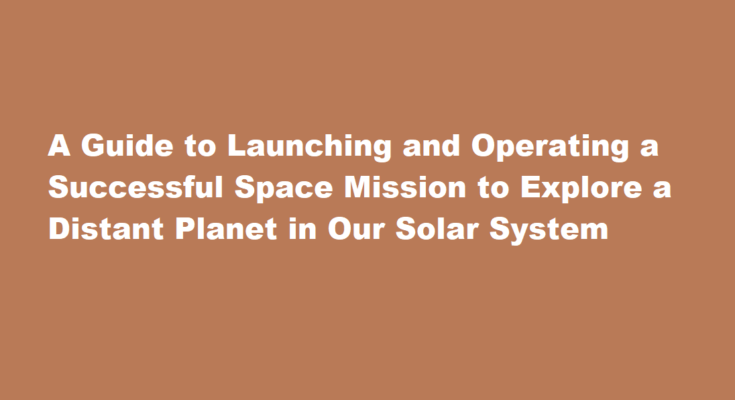Introduction
The human fascination with the mysteries of our universe has driven us to explore the far reaches of space. One of the most ambitious endeavors in space exploration is launching a mission to explore a distant planet within our solar system. To achieve success in such an endeavor, meticulous planning, cutting-edge technology, and unwavering dedication are required. In this article, we will delve into the key steps and considerations involved in launching and operating a successful space mission to explore a distant planet.
Mission Planning and Objective Setting
The foundation of any successful space mission lies in meticulous planning. The first step is to define clear objectives for the mission. What do you hope to discover or achieve? Are you interested in studying the planet’s surface, atmosphere, or magnetic field? Setting specific goals is crucial to guide the entire mission.
Selecting the Target Planet
Choose the target planet carefully based on your mission objectives and constraints. Factors like distance, orbital alignment, and planetary conditions play a significant role in the feasibility of a mission. Planetary alignment can significantly affect launch windows, so selecting the right planet at the right time is essential.
Mission Design and Trajectory
Developing the mission’s trajectory is a complex task that involves calculating orbital mechanics and ensuring the spacecraft’s path aligns with the target planet. The spacecraft may require gravity assists from other celestial bodies to reach its destination efficiently. Skilled engineers and astrophysicists are crucial in this phase.
Spacecraft Design and Construction
Creating a spacecraft capable of surviving the harsh conditions of space and conducting scientific experiments requires cutting-edge technology and materials. Collaborate with experts in various fields to design and construct a durable and efficient spacecraft. Ensure redundancy in critical systems to mitigate potential failures.
Launch and Transit
Select a launch vehicle that can carry your spacecraft and launch it into the desired trajectory. Timing is crucial, as launch windows are often narrow. During transit, monitor the spacecraft’s health and adjust its trajectory as needed to ensure it reaches the target planet on schedule.
Planetary Entry and Landing
If the mission involves landing on the target planet, design a robust entry, descent, and landing (EDL) system. The atmospheric conditions and surface terrain of the planet will influence your EDL strategy. Ensure the spacecraft is equipped with the necessary instruments to gather data during descent and landing.
Surface Operations
Once the spacecraft has successfully landed on the planet, it’s time to conduct surface operations. Deploy scientific instruments, cameras, and other equipment to collect data and images. Establish communication with mission control on Earth to receive and transmit data.
Data Analysis and Research
The success of a space mission lies not only in reaching the destination but also in the analysis of data collected. Collaborate with scientists and researchers to analyze the data and draw meaningful conclusions. Share discoveries with the scientific community and the public to promote scientific understanding and interest in space exploration.
Communication and Mission Control
Maintain robust communication with the spacecraft throughout the mission. Establish a dedicated mission control center staffed with experts who can monitor the spacecraft’s health, adjust its trajectory, and troubleshoot issues as they arise.
Budget and Funding
Space missions are expensive endeavors, and securing adequate funding is vital. Seek government support, private partnerships, and grants from space agencies or organizations interested in space exploration. Create a realistic budget and adhere to it to ensure the mission’s success.
Risk Mitigation
Space missions are fraught with risks, from technical failures to unpredictable space weather. Develop contingency plans for various scenarios, and ensure the mission has redundancy in critical systems to minimize the impact of failures.
Public Outreach and Education
Engage the public and promote scientific literacy by sharing mission updates, images, and findings through various media channels. Inspire the next generation of scientists and space enthusiasts by involving schools and educational institutions in mission-related activities.
FREQUENTLY ASKED QUESTIONS
What do we use to explore the solar system?
Telescopes on Earth and in orbit around Earth provide scientists with information about our solar system. That information is used to plan where spacecraft fly and where they “point their cameras.” NASA and other agencies send robotic spacecraft to fly by, orbit, or land on other planets and moons.
What are the methods of space exploration?
Space exploration is the use of astronomy and space technology to explore outer space. While the exploration of space is carried out mainly by astronomers with telescopes, its physical exploration is conducted both by uncrewed robotic space probes and human spaceflight.
Conclusion
Launching and operating a successful space mission to explore a distant planet in our solar system is a monumental task that requires meticulous planning, cutting-edge technology, and unwavering dedication. The pursuit of knowledge and the quest for discovery drive us to overcome the challenges of space exploration.
Read Also : Building Realistic Humanoid Robots with Advanced Artificial Intelligence Capabilities



